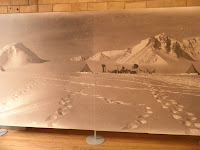Cheltenham's connection with Capt. Scott's Expedition to the South Pole
This fine statue on the Promenade in Cheltenham, Gloucestershire is of local hero Dr Edward Wilson who went on two Polar Expeditions to the Antarctic with Capt. Robert Falcon Scott.
The first one (1901 - 1904) on the ship the Discovery was supported by the Royal Society and The Royal Geographical Society and was primarily for scientific research as well as exploration. On this expedition Captain Scott, Ernest Shackleton and Dr Edward Wilson penetrated further south than any explorer had in the past and their valuable scientific research was more wide-ranging than any undertaken before, but they didn't cross the Great Ice Barrier to reach the South Pole.
Edward Wilson besides being an explorer was a physician, an artist, a naturalist as well as an ornithologist. He combined his important scientific work with beautiful paintings and drawings of the landscape and wildlife of this virtually unknown continent.
The second expedition (1910 - 1912), again led by Capt. Scott with Dr Wilson accompanying him, was specifically undertaken to reach the South Pole and to be the first explorers to do so, also, a large team of scientists travelled and worked alongside them to discover and gain more knowledge about the frozen continent.
Meanwhile, another very experienced team of explorers lead by a Norwegian, Roald Amundsen was raising money and preparing to travel to the Arctic to reach the North Pole. However, Amundsen's plans changed when he heard that rival explorers had reached the North Pole before him. Because he was unsure as to how his backers would react he secretly changed his objectives and headed South to be the first explorer to reach the South Pole instead. He announced his plans when he was well on his way.
When Scott heard that Amundsen had changed his plans he realised that it would be a race to get to the South Pole first.
The Antarctic Wilderness
 |
| The Antarctic Wilderness |
Capt Scott wrote in his diary "All day dreams must go. It will be a very wearisome return."
It was a battle through terrible freezing temperatures and blinding blizzards. Hauling their sledges was debilitating. Exhausted, starving and suffering from frostbite they slowly perished The frozen bodies of Capt Scott, Dr Edward Wilson and Henry Bowers were found in their tent months later. Evans and Oates bodies were never found. The frozen continent became their final resting place.
Dr Edward Wilson's statue on the Promenade in Cheltenham was sculpted by Captain Scott's widow Kathleen and bears the following inscription:-
Edward Adrian Wilson B.A. M.B. CANTAB. F.Z.S.
Born in Cheltenham 1872. Chief of the Scientific Staff.
Artist and Zoologist of the British Antarctic Expedition 1910 - 1913.
He reached the South Pole January 17 1912. And died with Capt. Scott
on the Great Ice Barrier March 1912.
"He died as he lived. A brave true man.
The best of Comrades and staunchest of friends"
(Letter from Capt. Scott)
For a guided walk around Cheltenham
Contact: Blue Badge Tour Guide - Anne Bartlett

